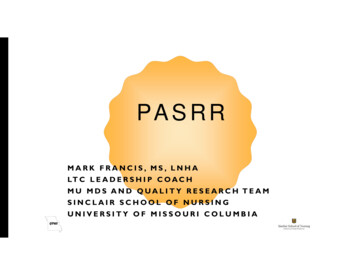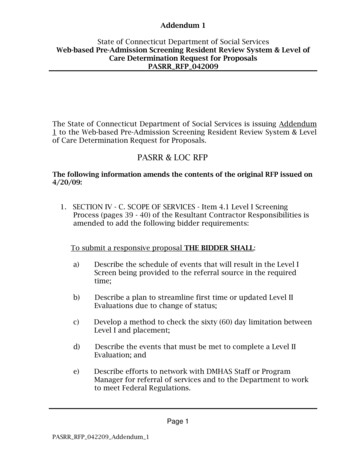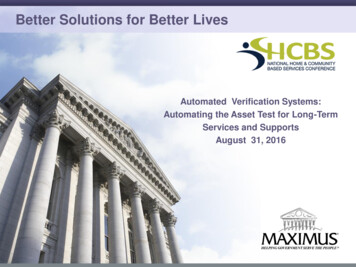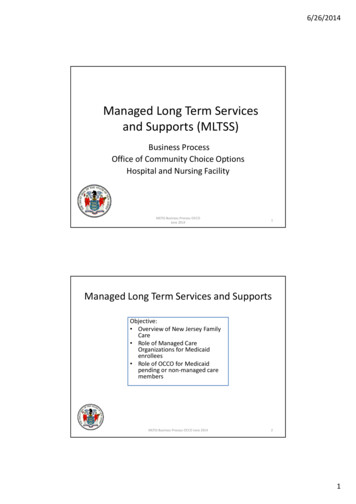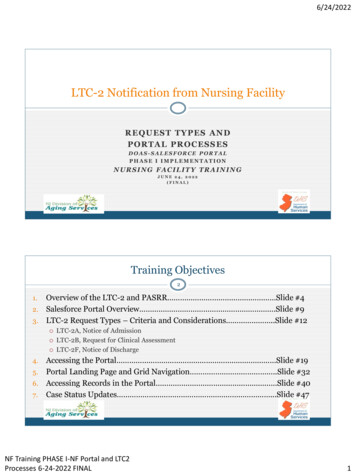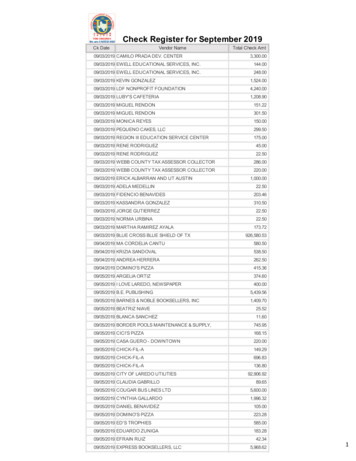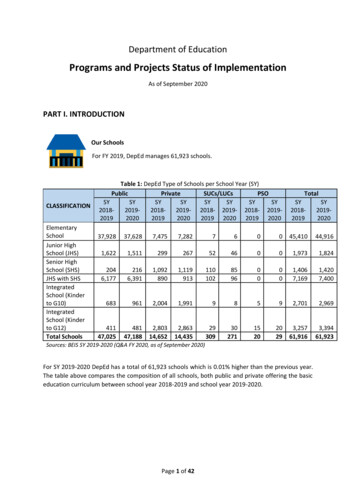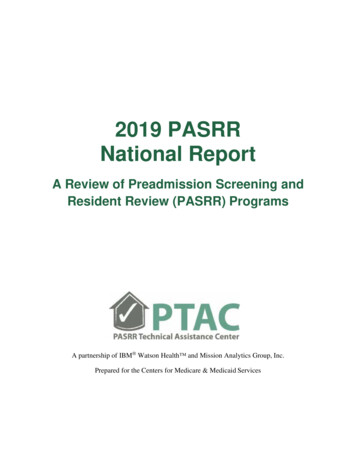
Transcription
2019 PASRRNational ReportA Review of Preadmission Screening andResident Review (PASRR) ProgramsA partnership of IBM Watson Health and Mission Analytics Group, Inc.Prepared for the Centers for Medicare & Medicaid Services
Table of ContentsExecutive Summary . 11Introduction . 32Quality Monitoring and Quality Improvement . 52.1Methods. 52.2Findings and Discussion . 73Prevalence of SMI, ID/RC, and Dual Diagnoses in NFs. 113.1Methods. 113.2Findings and Discussion . 124Prevalence of Problematic Behavioral Symptoms Among Individuals with PASRRDisabilities. 154.1Methods. 154.2Findings and Discussion . 155Prevalence of Dementia Among Individuals with an SMI . 175.1Methods. 175.2Findings and Discussion . 17About PTAC and Requesting Technical Assistance . 19AAppendix: Data Tables . 20A1Quality Monitoring and Quality Improvement Data Tables . 20A2Prevalence of SMI, ID/RC, and Dual Diagnoses in NFs . 344A2.1 Measure Definitions . 344A2.2 Data Tables . 355A3 Prevalence of Problematic Behavioral Symptoms Among Individuals with PASRRConditions . 39A4 Prevalence of Dementia Among Individuals with an SMI . 452019 PASRR National Report PASRR Technical Assistance Center December 2019 p. ii
List of TablesTable 1: Measures Linked to QM/QI in PASRR Systems. 6Table 2: Key Minimum Data Set Items . 11Table 3: Minimum Data Set Items Indicating Problematic Behavioral Symptoms. 15Table 4: States Able to Report on Quality Data Measures for SMI in 2017 (n 34) . 21Table 5: States Able to Report on Quality Data Measures for SMI in 2019 (n 35) . 233Table 6: States Able to Report on Quality Data Measures for ID/RC in 2017 (n 34) . 255Table 7: States Able to Report on Quality Data Measures for ID/RC in 2019 (n 35) . 277Table 8: States Able to Report on Quality Data Measures for Dual Diagnoses in 2017 (n 34) . 29Table 9: States Able to Report on Quality Data Measures for Dual Diagnoses in 2019 (n 35) . 30Table 10: Percentages of States Indicating They Collect Listed Quality Measures, by PASRRcondition and Year . 32Table 11: Number and Percentages of NF Residents Identified as Having SMI – BroadDefinition by Different MDS Measures (2016) . 355Table 12: Number and Percentages of NF Residents Identified as Having SMI – BroadDefinition by Different MDS Measures (2017) . 355Table 13: Number and Percentages of NF Residents Identified as Having SMI – BroadDefinition by Different MDS Measures (2018) . 366Table 14: Percentages of NF Residents Identified as Having SMI – Broad Definition by DifferentMDS Measures, by Year . 366Table 15: Number and Percentages of NF Residents Identified as Having SMI – NarrowDefinition by Different MDS Measures (2016) . 366Table 16: Number and Percentages of NF Residents Identified as Having SMI – NarrowDefinition by Different MDS Measures (2017) . 377Table 17: Number and Percentages of NF Residents Identified as Having SMI – NarrowDefinition by Different MDS Measures (2018) . 377Table 18: Percentages of NF Residents Identified as Having SMI – Narrow Definition byDifferent MDS Measures, by Year . 377Table 19: Number and Percentages of NF Residents Identified as Having ID/RC by DifferentMDS Measures (2016) . 388Table 20: Number and Percentages of NF Residents Identified as Having ID/RC by DifferentMDS Measures (2017) . 388Table 21: Number and Percentages of NF Residents Identified as Having ID/RC by DifferentMDS Measures (2018) . 388Table 22: Percentages of NF Residents Identified as Having ID/RC by Different MDS Measures,by Year . 39Table 23: Problematic Behavioral Symptoms of NF Residents with and without PASRR SMI(2016) . 39Table 24: Problematic Behavioral Symptoms of NF Residents with and without PASRR SMI(2017) . 4002019 PASRR National Report PASRR Technical Assistance Center December 2019 p. iii
Table 25: Problematic Behavioral Symptoms of NF Residents with and without PASRR SMI(2018) . 400Table 26: Percentages of NF Residents Showing Problematic Behavioral Symptoms in the MDS,with and without PASRR SMI, by Year . 411Table 27: Problematic Behavioral Symptoms of NF Residents with and without PASRR ID/RC(2016) . 422Table 28: Problematic Behavioral Symptoms of NF Residents with and without PASRR ID/RC(2017) . 422Table 29: Problematic Behavioral Symptoms of NF Residents with and without PASRR ID/RC(2018) . 422Table 30: Percentages of NF Residents Showing Problematic Behavioral Symptoms, with andwithout a PASRR ID/RC, by Year . 444Table 31: Dementia Diagnoses Among NF Residents with and Without a PASRR SMI (2016). 455Table 32: Dementia Diagnoses Among NF Residents with and Without a PASRR SMI (2017). 455Table 33: Dementia Diagnoses Among NF Residents with and Without PASRR SMI (2018) . 455Table 34: Percentages of NF Residents with Dementia Diagnoses, with and without PASRRSMI, by Year . 4662019 PASRR National Report PASRR Technical Assistance Center December 2019 p. iv
Executive SummaryPreadmission Screening and Resident Review (PASRR) is a federal Medicaid requirement thatmandates states operate programs designed to: (1) identify individuals who might be admitted toor reside in a nursing facility (NF) who have a serious mental illness (SMI), or an intellectualdisability or a related condition (ID/RC); (2) consider both NF and community placements forsuch individuals and recommend NF placement only if appropriate; and (3) identify the PASRRspecific needs that must be met for individuals to thrive, whether in a NF or the community. Thiseighth PASRR National Report provides data on the following: The ability of states to track data that may support quality monitoring and qualityimprovement (QM/QI);The prevalence of SMI and ID/RC in NFs across the country, as recorded in theMinimum Data Set (MDS) in the PASRR identification items as well as in otherdiagnostic items;The percentages of individuals who exhibit problematic behavioral symptoms towardthemselves or others, as recorded in the MDS; andThe percentages of NF residents with an SMI who have dementia, whose Level IIevaluations may be terminated early when the dementia is primary (42 CFR 483.128(m)).Section 1 of this report provides a brief overview of the PASRR requirements.Section 2 documents states’ self-reported capacity to track data about their program activitiesthat may support QM/QI, such as the number of Level I screens conducted, the number of thosescreens that resulted in a referral for Level II evaluation, and the number of Level II evaluations(before and after admission) that resulted in a positive determination of SMI or ID/RC. In 2019,35 states provided or confirmed information regarding their data collection practices. Of those,69 percent reported collecting information on at least half of the QM/QI measures for peoplewith an SMI as well as for people with ID/RC. This marks an increase from the 2017 NationalReport, in which we found that 59 percent of participating states reported collecting QM/QImeasures for both populations.Section 3 uses data from the MDS to report on the number of NF residents across the countrywho have been recorded in the MDS as having a PASRR-identified SMI or ID/RC, as comparedwith the number of residents who have been recorded on the MDS as having an SMI or anID/RC without a concurrent PASRR identification. A larger number of individuals are identifiedin the MDS as having SMI compared with those identified as having a PASRR SMI; the same isnot true for people with an ID/RC.Section 4 uses data from the MDS to examine the prevalence of problematic behavior symptomsamong PASRR-identified individuals compared with other NF residents. The results indicate thatproblematic behavior symptoms are more prevalent among PASRR-identified individuals thanamong the rest of the NF population.2019 PASRR National Report PASRR Technical Assistance Center December 2019 p. 1
Section 5 uses data from the MDS to explore the prevalence of dementia among individuals whohave a PASRR-identified SMI versus an SMI as recorded in other diagnostic items on the MDS.This analysis is mostly informational at this stage, as there are several limitations in the reportingof PASRR when NF residents are identified as having dementia in the MDS. The MDS does nothave a means of capturing people with an SMI who have been ruled out of PASRR due to havinga primary dementia diagnosis. Preliminarily, we found that individuals with an SMI but noPASRR diagnosis are more likely to have dementia identified than people identified with an SMIunder PASRR.2019 PASRR National Report PASRR Technical Assistance Center December 2019 p. 2
1IntroductionPreadmission Screening and Resident Review (PASRR) was added to Title XIX of the SocialSecurity Act in 1987 as part of the Nursing Home Reform Act. 1 PASRR has an important andunique role in Medicaid law. It requires states to (1) identify individuals who might be admittedto or reside in a nursing facility (NF) who have a serious mental illness (SMI), or an intellectualdisability or a related condition (ID/RC); (2) consider both NF and community placements forsuch individuals and recommend NF placement only if appropriate; and (3) identify the PASRRspecific needs that must be met for individuals to thrive, whether in a NF or the community.The regulations that govern PASRR (42 Code of Federal Regulations [CFR] § 483.100–138)require that states administer a PASRR program. PASRR programs must identify all individualswho are applying for NF admission, as well as NF residents, who have a possible SMI or ID/RC;this identification function is called Level I. Next, individuals with a possible SMI or ID/RC aregiven a more in-depth evaluation to confirm whether they have such a disability and, if so,whether they need Specialized Services to address their PASRR-related needs. The CFR callsthis a Level II evaluation. The PASRR program then issues a Level II determination, whichprovides recommendations for the setting in which services should be received, as well as anyNF services or Specialized Services necessary to support the individual’s SMI or ID/RC.PASRR is somewhat unusual for a Medicaid program in that, although the state’s Medicaidagency is ultimately responsible for compliance with federal regulations, responsibility for somePASRR activities is specifically assigned by statute to two other authorities. The state mentalhealth authority (SMHA) is responsible for making the Level II determinations for people withan SMI, and the state intellectual disability authority (SIDA) is responsible for makingdeterminations for people with an ID/RC. Aside from these critical components outlined above,program design and implementation are largely at the states’ discretion.This report examines issues explored in the 2016 and 2017 PASRR National Reports: the abilityof PASRR programs across the country to track the kinds of data that would support qualitymonitoring and quality improvement (QM/QI). As in previous years, we also analyzed data inthe Minimum Data Set (MDS) to assess the number and percentages of NF residents identifiedunder PASRR with an SMI or an ID/RC.We also include two new analyses. The first examines the prevalence of problematic behavioralsymptoms among PASRR-identified individuals compared with NF residents who have not beenPASRR-identified. The second details the prevalence of dementia among individuals with anSMI. People with primary dementia and secondary SMI are statutorily excluded from PASRRidentification (Section 1919(e)(7)(G)(i). They do not need to be identified in the MDS as havingPASRR SMI. These factors create challenges for drawing meaningful conclusions, but we1Social Security Act, 42 U.S. Code 1919(e)(7) (1987).2019 PASRR National Report PASRR Technical Assistance Center December 2019 p. 3
believe this initial analysis is an important first step in understanding the way state PASRRprograms interpret SMI in the presence of dementia.2019 PASRR National Report PASRR Technical Assistance Center December 2019 p. 4
2Quality Monitoring and Quality ImprovementQuality monitoring and quality improvement (QM/QI) indicators are critical for measuring andpromoting program success. Currently, states are responsible for developing and collecting theirown quality measures for PASRR.We developed a model list of QM/QI measures that we believe could help states track theoutcomes of their PASRR programs. Neither federal statute nor regulation requires states tocollect these model measures 2; rather, these measures have been identified as providing data thatwould be likely to help support a PASRR program’s activities. This basic framework for PASRRdata collection follows from the three main goals of PASRR:1. To evaluate all applicants to and residents of Medicaid-certified NFs for evidence of anSMI, or ID/RC;2. To ensure that such individuals are living in the most appropriate setting, whether in theNF or in the community, depending on their desires and needs; and3. To recommend PASRR-related services that individuals need, wherever they are placed.These model QM/QI measures fall into four broad categories: Level I screens, exempted hospitaldischarges (EHDs), Preadmission Level II evaluations and determinations, and Level II ResidentReviews and determinations. We analyzed state data collection capacity for people with an SMI,ID/RC and dual diagnoses of SMI and ID/RC separately. We examined measures for people withan SMI and ID/RC separately because separate state authorities are responsible for each type ofdetermination – the SMHA for people with an SMI and the SIDA for people with an ID/RC –and in some states, each authority might have a separate data collection process. Additionally,although the CFR does not separately identify individuals with a dual diagnosis, some statesconsolidate the evaluation for people with dual diagnoses and track them separately.2.1MethodsTable 1 lists the model QM/QI measures that states might collect and what we analyzed in ourassessment of current state QM/QI practices.2Current regulations at 42 CFR 483.112(c) require that states track whether Level II determinations are made withinan average of 7–9 working days from the date of referral. Section 1919(e)(7)(D)(iv) of the Social Security Actexpects that states can report on the number of individuals who were discharged from NFs because they no longerneeded NF level of services or no longer needed NF level of services and Specialized Services.2019 PASRR National Report PASRR Technical Assistance Center December 2019 p. 5
Table 1: Measures Linked to QM/QI in PASRR SystemsMeasureTotal # of NF Admissions StatewideTotal # of Level I evaluations performed statewide# of Level I evaluations that were done before admission% of Level I evaluations that were done before admission# of positive Level I evaluations% of Level I evaluations testing positive# of negative Level I evaluations% of Level I evaluations testing negativeExempted Hospital Discharges# of NF admissions# of NF admissions under EHDs% of NF admissions under EHDs# of EHDs with stays longer than 45 days% of EHDs longer than 45 daysPreadmission Evaluation (Preadmission Screens) – Level II Evaluations# of PAS – Level II evaluations# of PAS that were done before admission% of PAS that were done before admission# of positive PAS (i.e., finding of SMI or ID/RC)% of PAS leading to positive determinations# of positive determinations that recommend Specialized Services% of positive determinations that recommend Specialized Services# of categorical determinations% of categorical determinations# of positive PAS recommending either community placement or any institutional placement% of positive PAS recommending either community placement or any institutional placement# of positive PAS recommending any institutional placement (NF, ICF/IID, or inpatient psychiatric)% of positive PAS recommending any institutional placement (NF, ICF/IID, or inpatient psychiatric)# of positive PAS recommending institutional placement (ICF/IID or inpatient psychiatric)% of positive PAS recommending institutional placement (ICF/IID or inpatient psychiatric)# of positive PAS recommending institutional placement (NF)% of positive PAS recommending institutional placement (NF)# of positive PAS recommending community placement% of positive PAS recommending community placement# of positive PAS leading to institutional placement (NF)% of positive PAS leading to institutional placement (NF)# of positive PAS leading to institutional placement (ICF/IID or inpatient psychiatric)% of positive PAS leading to institutional placement (ICF/IID or inpatient psychiatric)# of positive PAS leading to community placement% of positive PAS leading to community placementAnnual average time (days) between Level I and Level II PAS determinationResident Review – Level II Evaluations# of RRs – Level II evaluations# of positive RRs (i.e., finding of SMI or ID/RC)% of RRs leading to positive determinations# of negative RRs (i.e., finding of no SMI, no ID/RC)% of RRs leading to negative determinations# of positive RRs recommending continued NF placement% of positive RRs recommending continued NF placement# of positive RRs recommending community placement% of positive RRs recommending community placement2019 PASRR National Report PASRR Technical Assistance Center December 2019 p. 6
Measure# of positive RRs leading to continued NF placement% of positive RRs leading to continued NF placement# of positive RRs leading to community placement% of positive RRs leading to community placementAbbreviations: EHD, exempted hospital discharge; ICF/IID, intermediate care facility for individuals withintellectual disability; ID, intellectual disability; NF, nursing facility; PAS, Preadmission Screens; PASRR,Preadmission Screening and Resident Review; QM/QI, quality monitoring and quality improvement; RC, relatedcondition; RR, Resident Review; SMI, serious mental illness.The states’ self-reported collection of these QM/QI measures was used as the basis of the 2016and 2017 National Reports. In order to allow states time to make measurable adjustments to theirdata collection processes based on the 2017 Report, in 2018, the National Report shifted focus tostates’ PASRR-related claiming of Federal Financial Participation.For the 2019 National Report, each state received a fact sheet developed using informationcollected for the 2016 and 2017 National Reports (consisting of data we gathered from publiclyavailable information about the states’ PASRR programs and information voluntarily supplied bythe states themselves). The fact sheet listed all of the recommended QM/QI measures andindicated (1) whether we had reason to believe that the states collected the information (marked“yes”), (2) whether we had reason to believe that the states did not collect the information(marked “no”), or (3) whether no information was publicly available or had been previouslyprovided by the state (marked “no information”).Work for the 2019 National Report began in early June of 2019 when PASRR program staffmembers in each state received the fact sheet for their state and were given the option to updatethe information that it contained. A reminder of this option was sent 2 weeks later to states thatdid not initially respond. Eighteen states (35 percent) updated their fact sheet, 17 states (33percent) acknowledged receiving the fact sheet but did not provide updates, and 16 states (31percent) did not respond.2.2Findings and DiscussionAppendix Section A1 presents a suite of tables displaying the number and percentage of statesindicating that they currently track the QM/QI measures listed above. Interested readers can findtables with data on these measures displayed separately for SMI, ID/RC, and dual diagnoses,both for 2017 and for 2019.The key table in Appendix Section A1 is Table 10, which summarizes the percentage of statesindicating they can collect each measure by PASRR condition and by year. Patterns emerge fromcomparisons within year, across disability type and measure type, and across years, withinPASRR condition and measure/measure type.In 2019, 35 states confirmed their data collection practices. Of those 35 participants, 69 percentreported collecting information on at least half of the QM/QI measures for people with an SMI as2019 PASRR National Report PASRR Technical Assistance Center December 2019 p. 7
well as for people with ID/RC. 3 This marks an increase from the 2017 National Report, in whichwe found that 59 percent of participating states reported collecting QM/QI measures for peoplewith an SMI and for people with an ID/RC.Looking more closely at some of the QM/QI measures in the 2019 data, we observe thefollowing: Number of Level Is performed preadmission. Level I screens must be performed foreligible NF applicants before admission to identify individuals with possible SMI orID/RC who will require Level II evaluations. Tracking whether Level Is were performedpreadmission helps ensure that the preadmission PASRR requirements are observed andensures that individuals with possible SMI or ID/RC are not inappropriately admitted toNFs. Of the 35 states that provided information for this report, 40 percent reportedcollecting data for this quality measure for people with an SMI as well as for people withan ID/RC.Number of positive Level Is. Tracking the receipt of positive Level Is helps ensure thatstate PASRR programs can promptly initiate the Level II evaluation process and identifyhow many resources must be allocated for Level IIs. Of the 35 states participating in thisreport, 63 percent reported collecting information for this measure for people with anSMI and 66 percent for people with ID/RC.Number of EHD admissions. EHDs, which exempts individuals from Level II evaluation,are applied when an individual seeks admission to a NF to convalesce from an illness orprocedure that required acute care and requires NF services for 30 calendar days orfewer, as certified by a physician. Tracking the number of EHD admissions allowsPASRR programs to identify possible misuse or overuse of the exemption. Of the 35states participating in this report, 40 percent reported collecting information for thismeasure for people with an SMI as well as for people with ID/RC.Number of EHD admissions with stays longer than 45 days. The CFR requires thatindividuals with possible SMI and ID/RC who were admitted under the EHD and whoend up staying in the NF for longer than the anticipated 30 days must be referred by theNF for a Resident Review by the 40th day of admission. Identifying EHD admissionswho, due to an extended stay, are still in the NF beyond the 40-day mark can help statePASRR programs verify that NFs are making the required referrals and that residentswith possible SMI or ID/RC are receiving the necessary Level II evaluations. Of the 35states participating in this report, 43 percent reported collecting information for thismeasure for people with an SMI as well as for people with ID/RC.3We would also note that of the 35 states that provided or confirmed data collection practices, 35 percent reportedtracking one or measures for people with dual diagnoses separately, while 63 percent collected 50 percent or moreQM/QI measures separately. More information about how states track QM/QI measures for people with dualdiagnoses is contained in the tables in Appendix Table 8 and Table 9.2019 PASRR National Report PASRR Technical Assistance Center December 2019 p. 8
Number of Level IIs (evaluations and determination) done preadmission. For NFapplicants with possible SMI or ID/RC (and who are not being admitted under an EHD),the Level II evaluation and determination process must be completed before admission.This ensures that applicants are not improperly admitted to a NF, and if they are admittedto a NF, they are not admitted without an appropriate plan for services. Tracking whetherLevel IIs were performed preadmission helps ensure that the preadmission PASRRrequirements are being observed. Of the 35 states that provided information for thisreport, 66 percent reported collecting data for this quality measure for people with anSMI and 63 percent for people with ID/RC.Number of preadmission Level IIs recommending Specialized Services. One of the twodeterminations PASRR programs make for people with an SMI or ID/RC is whether theindividual requires Specialized Services in the NF. Tracking the number of SpecializedServices recommendations helps PASRR programs confirm that all requireddeterminations are being made and provides a sense of how many people in NFs arereceiving Specialized Services. Of the 35 states that provided information for this report,74 percent reported collecting data for this quality measure for people with an SMI and80 percent for people with ID/RC.Number of preadmission Level IIs recommending community placement instead of NF orother institutional placement. Another critical function of PASRR is to help divertindividuals with an SMI or ID/RC whose needs can be met in a community setting rather
Executive Summary Preadmission Screening and Resident Review (PASRR) is a federal Medicaid requirement that mandates states operate programs designed to: (1) identify individuals who might be admitted to

